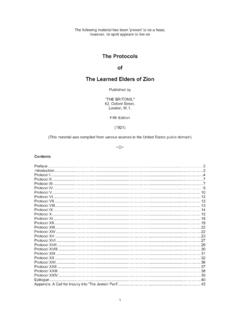Transcription of MORONS, IMBECILES, and IDIOTS - Campbell M Gold
1 1 MORONS, imbeciles , and IDIOTS Compiled by Campbell M Gold (2011) CMG Archives --()-- Introduction Two French psychologists, Alfred Binet and Theodore Simon, created the first "modern intelligence test" in 1911, which measured intelligence quotient ("IQ"). Intelligence Levels As psychologists developed and refined IQ Testing, classification systems were established, and any child with an IQ of above 70 was considered "normal", while those with scores above 130 were considered "gifted." Retardation Levels To classify scores below 70, psychologists invented a scale of "retardation" - Morons, imbeciles , and IDIOTS : Morons - Those with IQs between 51 and 70 (adequate learning skills to complete menial tasks and to communicate) imbeciles - Those with IQs between 26 and 50 (unable to progress past a mental age of approximately six) IDIOTS - those with IQs between 0 and 25 (poor motor skills, extremely limited communication, and little response to stimulus) The moron/imbecile/idiot classification system remained in use until the early 1970s.
2 2 (Above - taken from, "Better for All the World: The Secret History of Forced Sterilization and America's Quest for Racial Purity", Harry Bruinius, 2006, 2007) Today Today the classification system has been made one category broader, and the moron, imbecile, and idiot distinctions have been replaced with "mild", "moderate", "severe", and "profound" retardation. Moreover, diagnostic factors, in addition to "IQ", are also employed when classification is made. --()-- Mongolism The term "Mongolian idiot," which in the 19th and early 20th centuries was a specific diagnosis, derives from the urban myth that individuals with Down syndrome, with their wide set eyes and round faces, resembled Mongolians. Even before the British physician J H L Down (1828 - 1896) lent his name to the chromosomal syndrome, Down syndrome was known as "mongolism." --()-- Census Forms On older census forms (1851 to 1911) an individual's disabled/retarded state was requested.
3 3 Physical and Mental Infirmity Particulars, 1851 - 1911 A requirement that particulars should be given of those suffering from infirmities was first introduced into the schedule at the census of 1851. The form in which the question was put on each of the occasions on which it was asked is shown below. The example (Right) was taken from the 1881 UK Census Form The phrasing of these questions was identical throughout Great Britain except in 1911 when the Scottish schedule requested a statement whether the affliction dated from infancy instead of a statement of age. 1851 If Deaf-and-Dumb or Blind Write "Deaf-and-Dumb" or "Blind" opposite the name of the person. 1861 If Deaf and Dumb or Blind Write "Deaf and Dumb" or "Blind" opposite the name of the person; and if so from birth, add "from birth". 1871 If (1) Deaf and Dumb Write the respective infirmities against the name of the afflicted person; and if so from birth, add "from birth".
4 (2) Blind (3) Imbecile or Idiot (4) Lunatic 1881 As in 1871 As in 1871. 1891 If (1) Deaf and Dumb Write the precise infirmity, if any, opposite the name of the person; and if the infirmity dates from childhood, add "from childhood". Do not use such a general term as "afflicted" or "infirm". (2) Blind (3) Lunatic, Imbecile or Idiot 1901 If (1) Deaf and Dumb Write the precise infirmity, if any, opposite the name of the person; and if the infirmity dates from childhood, add "from childhood". Do not use such a general term as "afflicted" or "infirm". (2) Blind (3) Lunatic (4) Imbecile, Feeble-minded 1911 If any person included in this schedule is:- State the infirmity opposite that person's name and the age at which he or she became afflicted. (1) "Totally Deaf" or "Deaf and Dumb" (2) "Totally Blind" (3) "Lunatic" (4) "Imbecile" or "Feeble-minded" --()-- Definition The following interesting material is from an unknown origin: The exact definitions of terms such as 'lunatic', 'imbecile', 'idiot' and 'feeble-minded' are extremely problematic.
5 According to the 1881 Census Report; 4 No accurate line of demarcation can be drawn between the several conditions indicated by these terms. Speaking generally, however, the term idiot is applied in popular usage simply to those who suffer from congenital mental deficiency, and the term imbecile to persons who have fallen in later life into a state of chronic dementia. But it is certain that neither this nor any other definite distinction between the terms was rigorously observed in the schedules, and consequently no attempt has been made by us to separate imbeciles from IDIOTS . The term lunatic also is used with some vagueness, and probably some persons suffering from congenital idiocy, and many more suffering from dementia, were returned under this name. Considering that householders, who could be illiterate, were being asked to give information about medical disabilities without any definition of the terms being used the answers should be treated with caution.
6 Also they would be unwilling to admit that anyone in the family had medical disabilities. (1881 Census Report) When "feeble-minded" was substituted for "idiot" in the 1901 census the number of persons recorded with mental disability rose markedly, because, apparently the former term ["idiot"] was considered much more derogatory than the latter ["feeble-minded"]. (Original Source - Unknown) --()-- Terms In the past, some terms had a formal definition in the UK; however, they have been discontinued: IQ = 130+ Gifted IQ = 70+ Normal IQ = 0 to 25 - Idiot - Severe learning disability IQ= 25 to 50 - Imbecile - Moderate learning disability IQ = 50 to 70 - Moron or Feeble Minded - Mild learning disability An individual with an IQ of less than 50 usually requires care throughout their life and they are unlikely to be educable in the formal sense. --()-- Modern Retardation Classification IQ score ranges (from DSM-IV): Mild mental retardation: IQ 50-55 to 70; children require mild support; formally called "Educable Mentally Retarded".
7 Moderate retardation: IQ 35-40 to 50-55; children require moderate supervision and assistance; formally called "Trainable Mentally Retarded". Severe mental retardation: IQ 20-25 to 35-40; can be taught basic life skills and simple tasks with supervision. Profound mental retardation: IQ below 20-25; usually caused by a neurological condition; require constant care. --()-- 5 Appendix - Buck v. Bell Buck v. Bell, 274 200 (1927), was the United States Supreme Court ruling that upheld a statute instituting compulsory sterilization of the unfit, including the mentally retarded, "for the protection and health of the state." It was largely seen as an endorsement of negative eugenics-the attempt to improve the human race by eliminating "defectives" from the gene pool. " We have seen more than once that the public welfare may call upon the best citizens for their lives. It would be strange if it could not call upon those who already sap the strength of the State for these lesser sacrifices, often not felt to be such by those concerned, to prevent our being swamped with incompetence.
8 It is better for all the world, if instead of waiting to execute degenerate offspring for crime, or to let them starve for their imbecility, society can prevent those who are manifestly unfit from continuing their kind. The principle that sustains compulsory vaccination is broad enough to cover cutting the Fallopian "It is better for all the world, if instead of waiting to execute degenerate offspring for crime or to let them starve for their imbecility, society can prevent those who are manifestly unfit from continuing their "Three generations of imbeciles are enough." (Oliver Wendell Holmes) (Picture Right - Supreme Court Justice Oliver Wendell Holmes, Jr) Writing for the majority in the Supreme Court's affirmative decision of this landmark case, Oliver Wendell Holmes Jr. described Charlottesville native Carrie Buck as the "probable potential parent of socially inadequate offspring, likewise afflicted stating that her welfare and that of society will be promoted by her sterilization.
9 " (Picture below left - Carrie Buck (1906-1983); Right - Carrie with Emma Buck her mother, Virginia, 1924) Current scholarship shows that Carrie Buck's sterilization relied on a false diagnosis premised on the now discredited science of eugenics. It is likely that Carrie's mother, Emma Buck, was committed to a state institution because she was considered sexually promiscuous, that the same diagnosis was made about Carrie when she became an unwed mother at the age of 17 due to being raped, and that her daughter Vivian was diagnosed as not quite normal at the age of six months largely in support of the legal effort to sterilize Carrie. The effect of Buck v. Bell was to legitimize eugenic sterilization laws in the United States as a whole. While many states already had sterilization laws on their books, their use was erratic and effects practically non-existent in every state except for California.
10 After Buck v. Bell, dozens of states added new sterilization statutes, or updated their constitutionally non-functional ones already 6 enacted, with statutes which more closely mirrored the Virginia statute upheld by the Court. Sterilization rates under eugenic laws in the United States climbed from 1927 until Skinner v. Oklahoma, 316 535 (1942). While Skinner v. Oklahoma did not specifically overturn Buck v. Bell, it created enough of a legal quandary to discourage many sterilizations. By 1963, sterilization laws were almost wholly out of use, though some remained officially on the books for many years. Virginia's state sterilization law was repealed in 1974. --()-- Carrie Buck Carrie Buck (1906-1983) was a plaintiff in the United States Supreme Court case, Buck v. Bell, 274 200 (1927), and was ordered to undergo compulsory sterilization for purportedly being "feeble-minded.




